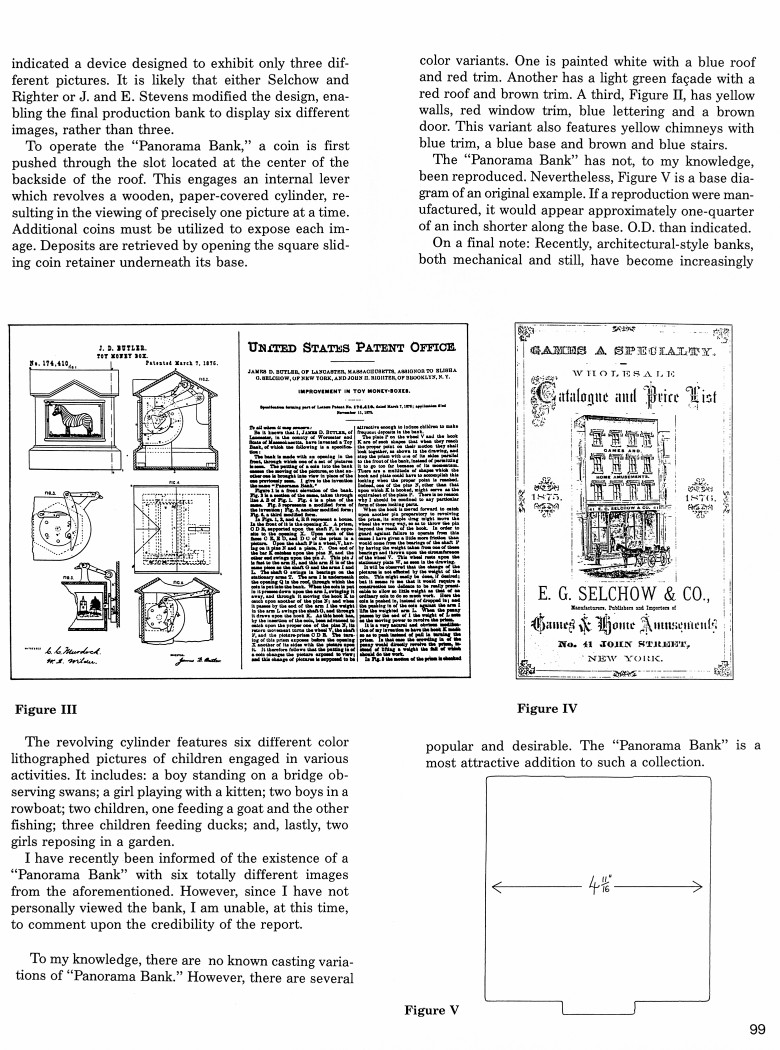|
The Panorama Bank
by Sy Schreckinger – ANTIQUE TOY WORLD Magazine – July, 1995
The design and manufacture of the first
cast-iron mechanical bank (Figure I) unknowingly effectuated the birth of
a major, worldwide industry. Mr. John D. Hall, of Watertown, Mass.,
invented and patented (December 21, 1869) his "Hall's Excelsior," a
mechanical bank in the form of a building (refer to Antique Toy World,
February 1984). His ingenious creation was the inspiration for eventual
production by other talented individuals of well over 400 varied
mechanical banks, spanning a period of approximately 40 years.
Although other subjects have enjoyed equal success and popularity,
the group comprised of buildings has been the most prolific in both the
mechanical and still bank families. Classics amongst the mechanicals
include: "Dog on Turntable," "Mosque," "Hall's Lilliput," "Cupola Bank,"
"Novelty Bank," "New Bank," "National Bank," "Home Bank," "U.S. Bank,"
"Zoo Bank," and the subject of this article, the "Panorama Bank" (Figure
II).
On March 7, 1876, James D. Butler, of Lancaster, Mass., received
patent number 174,410 for the invention of a most unique "building-style"
mechanical bank, namely his "Panorama Bank" (Figure III). Subsequently,
Butler assigned the patent rights to Elisha G. Selchow and John H.
Righter, two entrepreneurs who owned and operated a wholesale game and
home- amusement company located in New York City (see Figure IV). Selchow
and Righter ultimately contracted the J. and E. Stevens Foundry, of
Cromwell, Conn., to manufacture Mr. Butler's invention.
Interestingly, the original patent papers (Figure III) indicated a
device designed to exhibit only three different pictures. It is likely
that either Selchow and Righter or J. and E. Stevens modified the design,
enabling the final production bank to display six different images, rather
than three.
To operate the "Panorama Bank," a coin is first pushed through the
slot located at the center of the backside of the roof. This engages an
internal lever which revolves a wooden, paper-covered cylinder, resulting
in the viewing of precisely one picture at a time. Additional coins must
be utilized to expose each image. Deposits are retrieved by opening the
square sliding coin retainer underneath its base.
The revolving cylinder features six different color lithographed
pictures of children engaged in various activities. It includes: a boy
standing on a bridge observing swans; a girl playing with a kitten; two
boys in a rowboat; two children, one feeding a goat and the other fishing;
three children feeding ducks; and, lastly, two girls reposing in a garden.
I have recently been informed of the existence of a "Panorama Bank"
with six totally different images from the aforementioned. However, since
I have not personally viewed the bank, I am unable, at this time, to
comment upon the credibility of the report.
To my knowledge, there are no known casting variations of "Panorama
Bank." However, there are several color variants. One is painted white
with a blue roof and red trim. Another has a light green façade with a red
roof and brown trim. A third, Figure II, has yellow walls, red window
trim, blue lettering and a brown door. This variant also features yellow
chimneys with blue trim, a blue base and brown and blue stairs.
The "Panorama Bank" has not, to my knowledge, been reproduced.
Nevertheless, Figure V is a base diagram of an original example. If a
reproduction were manufactured, it would appear approximately one-quarter
of an inch shorter along the base. O.D. than indicated.
On a final note: Recently, architectural-style banks, both mechanical
and still, have become increasingly popular and desirable. The "Panorama
Bank" is a most attractive addition to such a collection.
|


